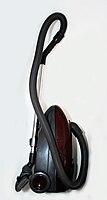
Photo from wikipedia
Abstract Horizontal vacuum belt filters are used for continuous solid–liquid separation in a wide variety of industrial processes. Despite the low pressure difference (usually Δp Click to show full abstract
Abstract Horizontal vacuum belt filters are used for continuous solid–liquid separation in a wide variety of industrial processes. Despite the low pressure difference (usually Δp < 0.8 bar), the high air pumping requirement to maintain the pressure difference results in considerable energy consumption. In this article, the specific energy consumption of vacuum filtration and air flow rates of a pilot-scale horizontal vacuum belt filter unit are investigated. The results show that a claw-type vacuum pump consumes only half the energy compared to a conventional liquid ring vacuum pump at corresponding operating points. A comparison between the specific energy consumption of vacuum filtration and thermal drying of the filter cake to zero moisture revealed that vacuum filtration accounted for less than half of the total energy consumption in the applied experimental conditions at Δp = 0.2–0.5 bar. The majority of the total pumping requirement of the pilot-scale filter resulted from leaks, and only 2–25% of the air flow found its way through the cake and the filter medium. The results suggest that there is a combination of the pressure difference level and the mass of solids deposited per filtration area that together with thermal drying consumes the least amount of energy per solids mass.
Journal Title: Drying Technology
Year Published: 2019
Link to full text (if available)
Share on Social Media: Sign Up to like & get
recommendations!